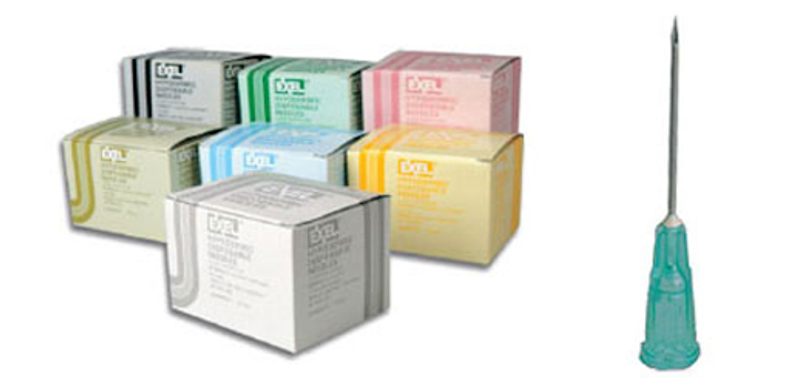When using a 30-gauge needle, it's important to follow safe injection practices, such as ensuring proper disinfection of the injection site, using the needle only once, and properly disposing of the used needle in a designated sharps disposal container.
Healthcare professionals know all too well the anxiety surrounding needle stick injuries and improper disposal. This guide aims to alleviate those worries by providing detailed steps on how to safely use and dispose of 30-gauge needles.
Backed by extensive research and practical knowledge gained from clinical settings, this comprehensive manual ensures you can perform your duties without added stress or risk.
Handling and Using 30 Gauge Needles Safely
When handling 30-gauge needles, safety is the top priority. These delicate needles require careful attention to ensure a smooth and risk-free injection process. Let's walk through the essential steps for using these needles safely.
Step I: Preparing Yourself
Before anything else, wash your hands thoroughly with soap and water. This simple step minimizes the risk of infection during the injection process. Make sure to dry your hands completely with a clean towel to avoid any residual moisture that could potentially contaminate the injection site.
Step II: Preparing the Injection Site
After your hands are clean, it's time to prepare the injection site. Take an alcohol swab and carefully clean the area where you plan to administer the injection. The alcohol will disinfect the skin, lowering the risk of infections. This step ensures that the needle enters a clean and sterile environment, reducing the chance of introducing harmful bacteria into your body.
Step III: Loading the Syringe
Next comes the crucial step of loading the syringe with medication. It's important to maintain a sterile technique throughout this process to prevent contamination. Ensure that there are no air bubbles in the medication by tapping the syringe and gently pushing the plunger until all air is expelled. Any air bubbles can affect the accuracy of the dosage and potentially lead to complications during injection.
Step IV: Administering the Injection
Once everything is prepared, it's time to administer the injection. Insert the needle at the recommended angle for your specific medication (usually 90 degrees for insulin). Push the plunger smoothly and steadily to deliver the medication into the intended area. After administering the medication, withdraw the needle smoothly to complete the process.
Step V: Immediate Disposal
Immediate disposal of used needles is crucial for safety. Always remember never to recap a needle after use. Immediately place the used needle in a sharps container to prevent accidental needle stick injuries. This important safety measure not only protects you but also ensures that others who may come into contact with the used needle are safe from potential harm.
How to Dispose of 30 Gauge Needles
When it comes to getting rid of used medical sharps like 30-gauge needles, it's essential to follow strict guidelines. These are crucial for your safety and cleanliness, as well as for the environment around you.
The FDA recommends a two-step process for properly disposing of used needles and sharps: Step 1 is to place all needles and sharps in a sharps disposal container immediately after use. Step 2 is to dispose of the filled sharps disposal container according to community guidelines. This ensures that the used needles are contained in an appropriate and secure manner, reducing the risk of accidental needle-stick injuries.
Using a Sharps Container
Sharps containers play a crucial role in ensuring the safe disposal of used needles, protecting both users and waste handlers from the risk of accidental injury. These containers are designed with specific features to prevent needle-stick injuries and to securely hold and transport used needles.
Benefits of Sharps Containers
One of the key benefits of using a sharps container is its ability to provide a secure and designated space for the containment of used needles. This not only reduces the risk of accidents but also maintains a clean and organized environment, promoting safe needle disposal practices at home, healthcare facilities, and other settings where sharps are utilized.
Alternative Disposal Methods
Sometimes, it's not always feasible to obtain a sharps container right away. In these instances, other disposal methods become crucial. Let's look into two common and reliable alternative methods for properly disposing of 30-gauge needles.
Mail-Back Programs
Mail-back programs offer a convenient solution for safe needle disposal. These services typically provide everything you need to safely package and ship your filled sharps container for proper disposal. While there may be a fee associated with these programs, they provide peace of mind, ensuring that the needles are handled in compliance with safety guidelines.
Drop-Off Sites
Community health centers, local pharmacies, or designated public drop-off sites often serve as collection points for used sharps. Before making a drop-off, it's crucial to verify the acceptance policies and operating hours of the designated sites.
Safety Practices for Needle Use
First and foremost, never share needles. Sharing needles increases the risk of transmitting severe infections such as HIV and hepatitis. Each individual should have their own needle to maintain a hygienic environment and prevent the spread of infectious diseases.
In addition to avoiding needle sharing, it's important to use needles only when necessary. Limiting the use of needles for essential medical purposes helps reduce the chances of accidental needlestick injuries and potential exposure to bloodborne pathogens.
When preparing injections for others, it is imperative to wear protective gloves. By wearing medical gloves during these procedures, you safeguard yourself and others from the risk of exposure to potentially infectious materials.

